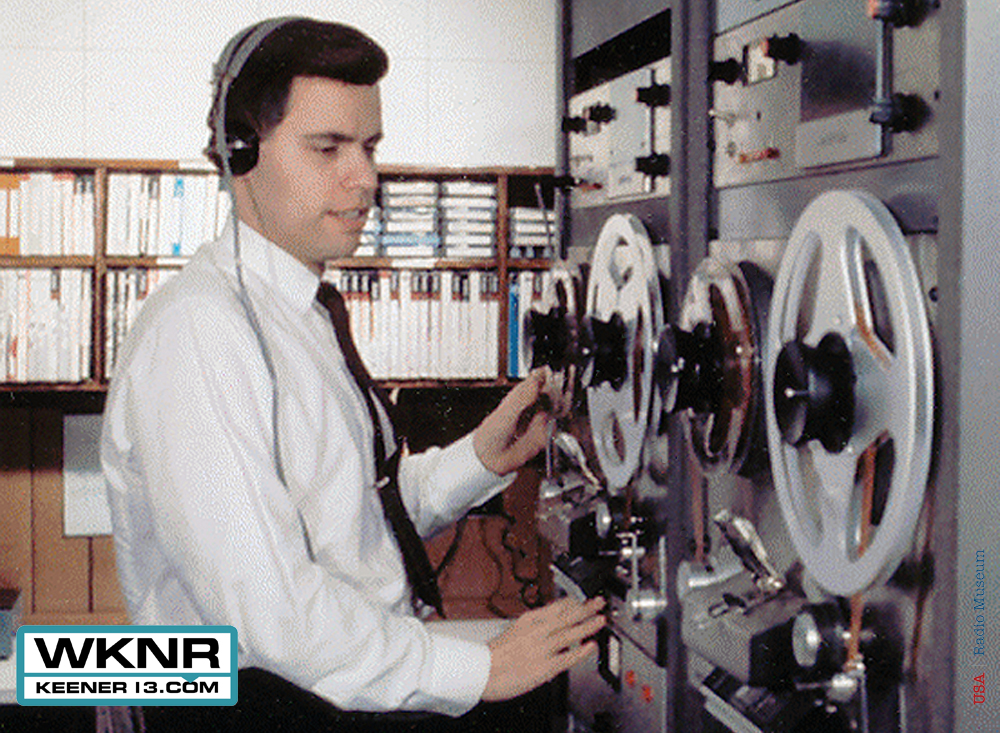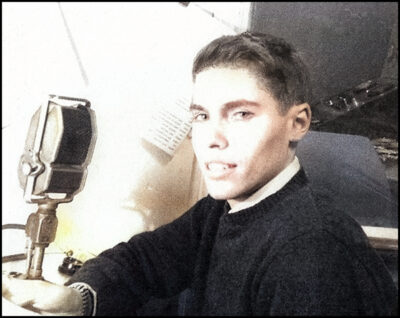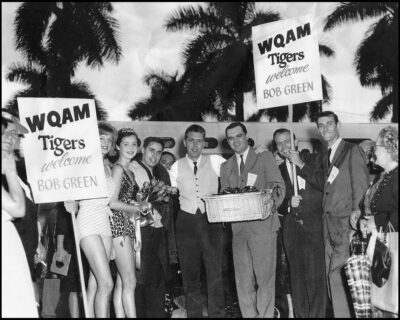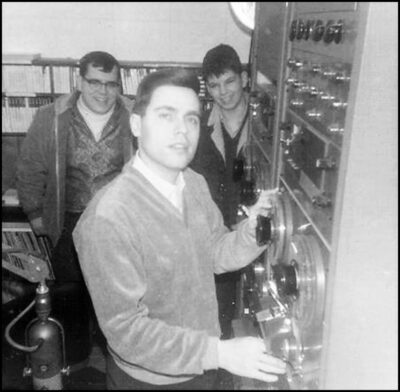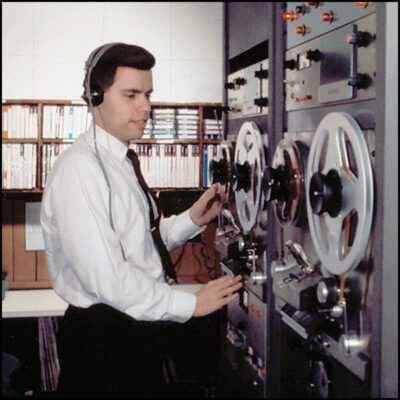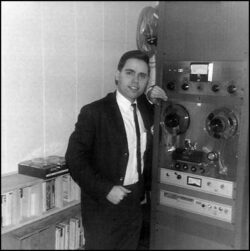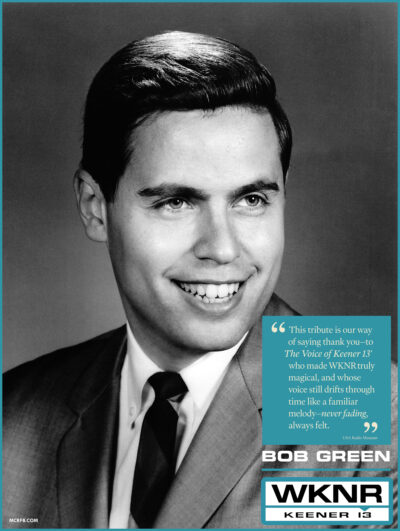Foreword . . . from the USA Radio Museum In the vast and vibrant history of American radio, few voices carried the warmth, wit, and wisdom of B
Foreword . . . from the USA Radio Museum
In the vast and vibrant history of American radio, few voices carried the warmth, wit, and wisdom of Bob Green. He wasn’t just a broadcaster—he was a bridge between generations, a trusted companion in living rooms and car rides, and a masterful communicator whose presence made the airwaves feel like home.
At the USA Radio Museum, we honor those who didn’t just play the hits, but shaped the heartbeat of a culture. Bob Green was one of those rare talents. His legacy lives on not only in the recordings and memories he left behind, but in the way he made each listener feel heard, valued, and connected.
This tribute is our way of saying thank you—to “The Voice of Keener 13” who made WKNR truly magical, and whose voice still drifts through time like a familiar melody—never fading, always felt. — USA Radio Museum
_____________________
From Rochester to Miami: The Early Frequencies
Before he became one of the defining voices of Detroit radio, Bob Green’s story began quietly in upstate New York, nestled in the studios of WSAY and WGVA. As “Mac McGuire,” he took to the microphone with youthful resolve and endless curiosity—working marathon shifts that tested both his stamina and creativity. It was here that Bob learned the delicate balance between rhythm and restraint, improvisation and structure.
He was deeply influenced by WBZ-Boston luminaries Bruce Bradley and Jim Holt. Holt’s energetic “sing-along” segments caught Bob’s ear and imagination, and he briefly tried emulating them—until realizing that his gift wasn’t in melody, but in meaning.
“It took about a day to realize singing wasn’t my thing,” Bob would later joke. “But storytelling? That was my lane.”
At WGVA, Bob began carving out his signature delivery: crisp, authentic, and personal. This wasn’t just performance—it was connection. Even in those early broadcasts, he made listeners feel like part of the story.
In the early 1960s, Bob’s talent began attracting wider attention. Opportunity knocked from farther down the dial—and farther across the map.
Detroit Beckons: WKMH and the Pre-Keener Prelude
In 1961, Detroit was a city on the cusp of sonic transformation. Motown was beginning to pulse through its streets, and radio was racing to keep up. Into this vibrant mix stepped Bob Green, freshly seasoned from his New York stations and ready to make his mark. WKMH, though not yet a powerhouse, was a station with ambition—and Bob was part of its early push toward relevance.
His time at WKMH was brief, but it placed him in rare company. The station’s roster read like a who’s who of Detroit radio: Lee Alan, Ray Otis, Robin Seymour, Dave Prince, Dick Buller—and possibly as well, Paul Cannon. These were voices that would soon define the city’s airwaves, and Bob was right there with them, absorbing the energy and sharpening his instincts.
WKMH was still finding its identity, experimenting with formats and talent. Bob’s presence added a layer of polish and professionalism, even as the station navigated its growing pains. He brought with him the lessons of Rochester and Geneva, the pacing of WBZ, and the hunger to connect.
“Detroit was electric,” Bob recalled. “You could feel the change coming—not just in music, but in how radio spoke to people.”
Though WKMH didn’t yet have the reach or swagger of its competitors, it gave Bob a front-row seat to the city’s cultural shift. He witnessed firsthand the rise of Motown, the evolution of Top-40, and the emergence of radio as a communal force. And while his next move would take him south to Miami, Detroit had already left its imprint.
This chapter also marked the beginning of relationships that would echo through Bob’s career. Many of the voices he worked alongside at WKMH would reappear in later stations, projects, and memories. It was a brief stop—but a meaningful one.
Miami Heat: WQAM and the Storz Format
After his Detroit detour, Bob Green packed up his instincts and headed for warmer airwaves. Miami’s WQAM—part of the legendary Storz Broadcasting empire—was a hotbed of Top-40 innovation, and Bob arrived just as the format was hitting its stride. It was 1963, and WQAM’s “Fabulous 56” was more than a playlist—it was a cultural force.
Todd Storz had revolutionized radio by distilling programming into a tight rotation of hits, jingles, and personality-driven segments. Bob fit right in. His voice adapted effortlessly to the Miami tempo—brassy, bold, and breezy. He embraced the station’s high-energy vibe, complete with echo effects, punchy promos, and a jingle package that sounded like it was beamed in from outer space.
“Things were swingin’ in Miami,” one WQAM jingle proclaimed. “It’s the Sky High Sound of WQAM. You’re in orbit—welcome aboard the spaceship.”
Bob’s airchecks from this era reveal a DJ at the top of his game: playful, precise, and deeply attuned to his audience. He wasn’t just announcing songs—he was orchestrating moods. Whether teasing a Beach Boys single or delivering a sirloin commercial with flair, Bob made every moment memorable.
Behind the mic, he also contributed to production—crafting transitions, shaping sound design, and experimenting with audio textures that would later influence his work at WKNR and beyond. Miami gave Bob a new palette, and he painted with gusto.
Though his time at WQAM was relatively short, it was a masterclass in adaptability. Bob proved he could thrive in any market, under any format, and still make it feel like home. And while the Magic City sparkled, Detroit’s pull remained strong.
Bob Green | WQAM 560 | Miami, Florida 1963
Audio Digitally Remastered by USA Radio Museum
The Keener Revolution: WKNR and the Sound of Change
When WKMH flipped formats and rebranded as WKNR on October 31, 1963, Detroit radio was forever changed. The station—soon affectionately known as Keener 13—rocketed from obscurity to dominance, and Bob Green was one of the voices steering that ascent. As one of the original Keener jocks, Bob helped shape a sound that was fresh, fast, and fiercely listener-focused.
Bob’s arrival at WKNR was serendipitous. A friend had sent him a tape of WKMH’s jingle package, and intrigued by its polish, Bob reached out to the station. Though the program director had just been replaced, Bob’s audition landed in the hands of Frank Maruca, who saw something special. Bob was hired—and history was set in motion.
While Bob Green’s radio journey began in upstate New York, but it was Miami’s WQAM that truly shaped his style and confidence. In 1963, Bob was already making waves at WQAM, part of the Storz Broadcasting empire, where he embraced the high-energy Top-40 format with flair. His voice became a fixture in the Magic City’s soundscape, and his production instincts sharpened in the fast-paced, jingle-rich environment.
“Things were swingin’ in Miami,” one WQAM jingle proclaimed. “You’re in orbit—welcome aboard the spaceship.”
It was during this Miami chapter that Frank Maruka—the visionary program director behind Keener’s transformation—returned Bob’s call. It was in September 1963 when Maruka called Bob in Miami, inviting him to join a bold new experiment in Detroit: the rebranding of WKMH into WKNR, a station that would soon become Keener 13. Bob accepted—and history was about to be made.
On October 31, 1963, WKNR officially launched, and Bob Green was there from day one. His Miami-honed instincts and production savvy helped shape Keener’s tight playlist, crisp delivery, and listener-first philosophy. Bob wasn’t just a DJ—he was a founding architect of the Keener sound.
At Keener, Bob’s delivery was magnetic. He had a way of making every record feel like a personal recommendation, every weather update sound like a shared moment. His voice was warm but precise, and his timing—especially in the tightly formatted Top-40 world—was impeccable. He wasn’t just spinning hits; he was crafting atmosphere.
“We weren’t just DJs,” Bob said. “We were companions, guides, sometimes even therapists. Radio was intimate.”
WKNR’s rise was meteoric. Within months, it had leapfrogged competitors like WJBK and WXYZ, becoming Detroit’s No. 1 station by early 1964. Bob was there for the ride, anchoring the sound and spirit of Keener during its golden years. His on-air chemistry with fellow jocks like Mort Crowley, Robin Seymour, Gary Stevens, and Bill Philips created a sense of community that listeners felt deeply.
Behind the scenes, Bob was also a production wizard. He helped shape the station’s sonic identity through jingles, promos, and transitions that were as stylish as they were strategic. His understanding of pacing and mood turned WKNR into more than a station—it was a vibe.
Even as competition intensified—especially from CKLW’s “Boss Radio” format—Bob remained a steady presence. By 1968, WKNR began revamping its lineup, and Bob eventually stepped away. But his impact was indelible. He had helped build a station that defined an era, and his voice became part of Detroit’s cultural memory.
Bob Green | WKNR Keener 13 | February 1964
Audio Digitally Remastered by USA Radio Museum
_____________________
Sidebar: Bob Green’s “Keener Philosophy”
“We didn’t just play records. We created moments. That was the Keener way.”
—Bob Green
Bob Green’s guiding principle at WKNR wasn’t just about programming—it was about emotional resonance. He called it the Keener Philosophy:
- Simplicity: Strip away the clutter. Let the music and message shine.
- Spontaneity: Keep it fresh, alive, and unpredictable.
- Sincerity: Speak with heart. Connect with listeners like friends.
Bob believed radio should be clean, compelling, and connective. Every jingle, every segue, every spoken word had a purpose: to make the listener feel something.
Even decades later, his philosophy remains a blueprint for broadcasters who understand that great radio isn’t just heard—it’s felt.
Bob Green | WKNR Keener 13 | May 1967
Audio Digitally Remastered by USA Radio Museum
_____________________
A Night to Remember: Bob Green Introduces the Beatles
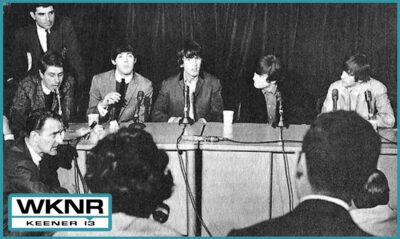
WKNR introduces the Beatles to the Detroit press at the Olympia. September 6, 1964 (Credit: Motor City Radio Flashbacks Archives)
On September 6, 1964, Bob Green stepped onto the stage at Olympia Stadium in Detroit—not as a DJ, but as a cultural conduit. That night, in front of 30,000 electrified fans, he introduced The Beatles during their first North American tour. The roar of the crowd, the flash of cameras, the palpable hysteria—it was Beatlemania in full bloom, and Bob was at the heart of it.
“We were up there talking for a while to sort of fill time … Someone shouted out, ‘Get the hell off the stage, we want to see the Beatles!’”
—Bob Green
It wasn’t just a concert—it was a generational moment, and Bob helped shape it. His voice, already familiar to Keener listeners, became the bridge between Detroit and Liverpool, between radio and rock history. That day, Bob Green didn’t just introduce a band—he introduced a movement (and sound) which went on to captivate the WKNR playlists during the nearly-9 years WKNR was on the air.
Bob Green Productions | WKNR ‘Beatles in Detroit’ Radio Promos | September 1964
Audio Digitally Remastered by USA Radio Museum
Shakeups and Second Acts: WKNR’s Twilight and Bob’s Return
By April 1968, WKNR—once the crown jewel of Detroit radio—was facing mounting pressure. Ratings were slipping, CKLW’s “Boss Radio” format was surging, and management made a controversial decision: they let go of several of Keener’s highest-paid and most beloved personalities. Among them were Bob Green, Ted Clark, Jerry Goodwin, and Scott Regen. Dick Purtan had left for Baltimore and returned to Detroit for WXYZ. It was a seismic shift that marked the beginning of Keener’s decline.
But Bob wasn’t done with Keener. In 1970, he returned—not just as a DJ, but as Program Director, tasked with breathing new life into the station. With characteristic loyalty and vision, Bob brought back Scott Regen, who had been working at CKLW. Together, they attempted to rekindle the Keener magic, assembling a fresh lineup that included Jim Tate, Mac Owens, Ron Sherwood, Bill Garcia, Dan Henderson, and Pat St. John.
“During Bob’s service as PD, Keener’s sound was as exciting and creative as ever,” Pat St. John later said. “He communicated and entertained—the two main ingredients that made for great radio.”
Despite their best efforts, the station’s momentum couldn’t be sustained. After nearly a year and a half, Bob and Scott exited WKNR. The station was sold, and the Keener era quietly faded into history.
Bob’s next move was a brief stint at WXYZ 1270, the ABC-owned Detroit station known for its rich legacy and Top-40 pedigree. Though short-lived, this chapter allowed Bob to reconnect with listeners one last time before turning the page.
In late 1972, Bob and family left the Motor City and headed south to Houston, Texas, where a new chapter awaited—one that would carry his voice and vision into the world of commercial production and audio branding.
Bob Green | WKNR Keener 13 | February 1971
Audio Digitally Remastered by USA Radio Museum
Bob Green Productions: Crafting Soundtracks for Brands and Moments
 After leaving Detroit in late 1972, Bob Green settled in Houston, Texas, where his creative energy found a new outlet: commercial audio production. There, he founded Bob Green Productions, a studio that would become his playground for branding brilliance and auditory storytelling.
After leaving Detroit in late 1972, Bob Green settled in Houston, Texas, where his creative energy found a new outlet: commercial audio production. There, he founded Bob Green Productions, a studio that would become his playground for branding brilliance and auditory storytelling.
While many of his peers faded into retirement or stayed tethered to traditional radio, Bob pivoted with vision. He engineered radio and TV spots, developed branding packages for stations across the country, and infused each production with the same spark that lit up WKNR’s airwaves. His background as both a DJ and Program Director gave him a rare blend of instincts—he knew how to sell, how to sizzle, and how to speak directly to the soul of an audience.
Clients weren’t just drawn to Bob’s technical skills. They came for his voice, his timing, and his deep understanding of listener psychology. Whether it was a jingle, promo, or PSA, Bob made sound feel cinematic. In every waveform, you could hear the echoes of Detroit’s golden era—and a man who never stopped evolving.
Though he is retired today, Bob Green’s creative fingerprint endures. He occasionally takes on passion projects, remains engaged with radio friends and museum archivists, and is still considered one of the most artful communicators in the industry.
Bob Green | 13 Various Commercial Ads | Bob Green Productions
Audio Digitally Remastered by USA Radio Museum
Legacy in Reverberation
Bob Green’s legacy doesn’t live in archives alone—it reverberates. In the cadence of today’s DJs who still believe in storytelling. In the museum playlists that pulse with the same energy he once curated. In the quiet moments when someone hears an old jingle and smiles, remembering where they were when Bob first played it.
His influence is subtle but enduring. You hear it in the way Detroit radio still values personality. You feel it in the warmth of tribute broadcasts that honor not just the hits, but the heart behind them. Bob’s voice may no longer fill the airwaves, but his style, his spirit, and his standard remain.
He taught us that radio could be intimate. That a well-placed pause could say more than a paragraph. That music was memory, and the DJ was its guardian.
And now, through the USA Radio Museum, Bob Green’s story continues—not as a relic, but as a resonance. His name joins the pantheon of voices who shaped the soundscape of a generation. And his legacy, like the best kind of radio, plays on.
The Later Years: Broadcasting, Mentorship, and Legacy
Following his impactful chapters in Miami and Detroit, Bob Green continued to grace the airwaves across various stations—each new gig an extension of his mastery. Whether consulting on programming, lending his voice to production, or mentoring young talent, Bob’s presence was synonymous with integrity and excellence.
Throughout the 1970s and beyond, Bob transitioned into roles that allowed him to shape radio behind the scenes. His expertise in timing, audience connection, and station identity became a blueprint for others. He was never one to chase fame; his focus remained on authenticity and storytelling.
He eventually retired to Austin, Texas, a city known for its music scene—a fitting backdrop for reflection. Here, Bob found solace and rhythm off the mic. But his legacy didn’t fade—it ripened. He looked back with humility, grateful for the decades of voices, stations, and listeners who made his journey unforgettable.
Tragically, in April of 2023, Bob lost his beloved wife, Sandi, after 58 years of marriage. Their love story was one of quiet strength and unwavering devotion. Sandi was there through every broadcast, every format flip, every milestone—a co-architect of Bob’s life beyond the soundboard.
This coming November 24, Bob and his family will observe his 88th birthday. And while he may no longer hold court on the airwaves, those who tuned in will always remember the companionship, joy, and resonance he offered.
“Radio gave me a stage,” Bob once said. “But the listeners gave me a purpose.”
Emotional Resonance: What Bob Gave Us
 Bob Green didn’t just play records—he played emotion. His voice carried more than sound; it carried presence. Whether introducing a Motown hit, teasing a Beatles premiere, or delivering a heartfelt PSA, Bob had a way of making listeners feel like they were part of something bigger. He turned radio into ritual.
Bob Green didn’t just play records—he played emotion. His voice carried more than sound; it carried presence. Whether introducing a Motown hit, teasing a Beatles premiere, or delivering a heartfelt PSA, Bob had a way of making listeners feel like they were part of something bigger. He turned radio into ritual.
Listeners remember the tone of his voice more than the titles he spun. It was warm, confident, and always in rhythm with the moment. He could lift spirits with a single phrase, or slow time with a thoughtful pause. Bob understood that radio wasn’t just about broadcasting—it was about belonging.
His emotional resonance extended beyond the mic. He mentored talent with generosity, collaborated with producers like a true partner, and treated every station—whether WKMH, WQAM, WKNR, or WXYZ—as a community. Even in his later years, through Bob Green Productions, he infused commercials and branding with that same human touch.
“Bob didn’t just talk to us,” one longtime avid Keener 13 listener recently emailed USA Radio Museum. “He became one of us on Keener 13.”
In a world of formats and frequencies, Bob Green gave us feeling. He reminded us that radio could be personal, poetic, and powerful. And in doing so, he became more than a broadcaster—he became more than just another radio name, Bob Green. He will be remembered always and affectionately, as he was then . . . ‘The Voice of Keener 13′.
_____________________
Closing Note of Gratitude
 As we celebrate the life and legacy of Bob Green, the USA Radio Museum wishes to extend sincere thanks to Scott Westerman and the team at Keener13.com for their invaluable contributions to this tribute.
As we celebrate the life and legacy of Bob Green, the USA Radio Museum wishes to extend sincere thanks to Scott Westerman and the team at Keener13.com for their invaluable contributions to this tribute.
The insights shared in Scott Westerman’s 2003 interview with Bob Green offered not only historical depth, but a rare emotional intimacy—bringing Bob’s voice, humor, and philosophy vividly to life. Their archival work continues to be a beacon for those of us who believe in the power of radio to connect, inspire, and endure.
We are honored to build upon the foundation they’ve preserved, and grateful for the generosity that allows us to share Bob’s story with new generations.
Thank you, Scott. Thank you, Keener13.com.
_____________________
A USARM Viewing Tip: On your PC? Mouse/click over each image for expanded views. On your mobile or tablet device? Finger-tap all the above images inside the post and stretch image across your device’s screen for LARGEST digitized view. A special ‘Thank You’ to Steve Schram and Scott Westerman for the images, featured here, as credited to keener13.com.

